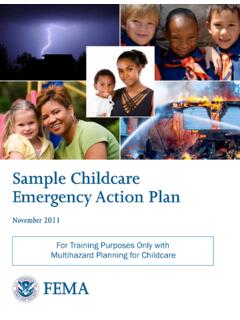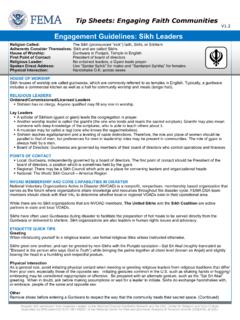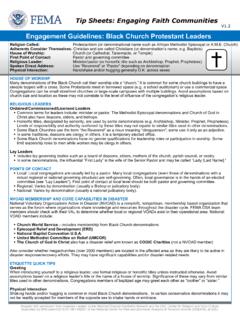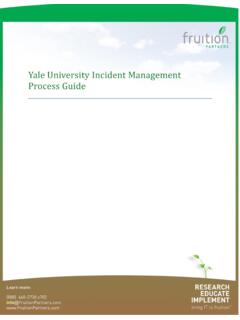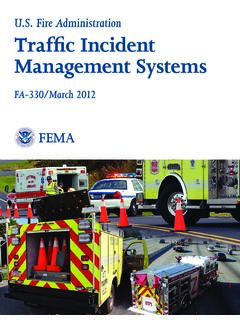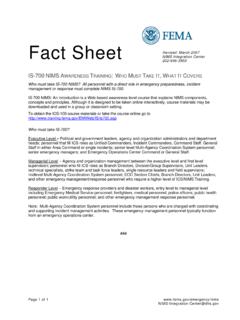Transcription of National Incident Management System
1 National Incident Management System Third Edition October 2017. National Incident Management System ii Secretary Department of Homeland Security Washington, DC 20528. Homeland Security October I 0, 20 17. Dear National Incident Management System Community: Originally issued in 2004, the National Incident Management System (NIMS) provides a consistent nationwide template to enable partners across the Nation to work together to prevent, protect against, respond to, recover from, and mitigate the effects of incidents, regardless of cause, size, location, or complexity. Since the Federal Emergency Management Agency (FEMA) last revised the NIMS. guidance in 2008, the risk environment has evolved, and our National Incident Management capabilities have matured.
2 This revision incorporates lessons learned and best practices from a wide variety of disciplines, at all levels of government, from the private sector, tribes, and nongovernmental organizations. The FEMA Administrator, in his role as the head of the National Integration Center, is charged with managing and maintaining NIMS, and in accordance with the Post-Katrina Emergency Management Reform Act, will issue the revised NIMS guidance and support its implementation. I believe this revised version of NIMS advances our National preparedness and takes us collectively into the future of Incident Management . Sincerely, Acting Secretary Elaine C. Duke National Incident Management System iv Department of Homeland Security Washington, DC 20472.
3 October 10, 2017. Dear NIMS Community: Since the Department of Homeland Security first published the National Incident Management System (NIMS) in 2004, our Nation has made great strides in working together before, during, and after emergencies and planned events. Every day, men and women from a wide variety of organizations work together to save lives and protect property and the environment. This National unity of effort strengthens organizations across the whole community by enabling them to share resources and help one another in times of need. To keep NIMS guidance pertinent, accurate, and up-to-date, FEMA engaged partners and practitioners from a wide variety of disciplines, at all levels of government, from the private sector, tribes, and nongovernmental organizations.
4 This document retains much of the material from the 2008 version of NIMS. It synchronizes the guidance with changes to laws, policies, and best practices, and adds information on the roles of off-scene Incident personnel, including senior leaders and staff in emergency operations centers. Perhaps more than any other homeland security guidance, NIMS has always been, and continues to be, the product of practitioners, based on the experience of emergency personnel who respond to incidents every day. As NIMS continues to mature, its purpose remains the same: to enhance unity of effort by providing a common approach for managing incidents. I believe that this document advances that cause and I am pleased to approve and endorse this revised version of NIMS.
5 Sincerely, Brock Long Administrator National Incident Management System vi National Incident Management System Contents I. Fundamentals and Concepts of NIMS .. 1. Introduction .. 1. Applicability and 2. NIMS Guiding Principles .. 3. 3. Standardization .. 3. Unity of Effort .. 3. Background .. 3. Key Terms .. 4. Supersession .. 5. II. Resource Management .. 6. Resource Management Preparedness .. 6. Identifying and Typing Resources .. 6. Qualifying, Certifying, and Credentialing Personnel .. 7. Planning for Resources .. 8. Acquiring, Storing, and Inventorying 9. Resource Management During an 12. Identifying Requirements .. 12. Ordering and Acquiring .. 13. Mobilizing .. 15. Tracking and Reporting .. 16. Demobilizing .. 16. Reimbursing and Restocking.
6 16. Mutual Aid .. 17. Mutual Aid Agreements and Compacts .. 17. Mutual Aid 17. III. Command and 19. NIMS Management 20. Common 20. Modular 20. Management by Objectives .. 21. Incident Action Planning .. 21. Manageable Span of Control .. 21. Incident Facilities and Locations .. 22. Comprehensive Resource 22. Integrated Communications .. 22. Establishment and Transfer of Command .. 22. Unified Command .. 22. Chain of Command and Unity of Command .. 23. Accountability .. 23. Dispatch/Deployment .. 23. Information and Intelligence Management .. 23. vii National Incident Management System Incident Command System (ICS).. 24. Incident Command and Unified Command .. 24. Command Staff .. 27. General Staff .. 28. Common Types of ICS Facilities.
7 31. Incident Management Teams .. 32. Incident Complex: Multiple Incident Management within a Single ICS Organization .. 33. Area Command .. 33. Emergency Operations Centers (EOC) .. 35. EOC Staff Organizations .. 36. EOC Activation and Deactivation .. 38. Multiagency Coordination Group (MAC Group) .. 40. Joint Information System (JIS) .. 42. System Description and Components .. 42. Public Information Communications 46. Interconnectivity of NIMS Command and Coordination Structures .. 47. Federal Support to Response Activities .. 47. IV. Communications and Information Management .. 50. Communications Management .. 52. Standardized Communication Types .. 52. Policy and Planning .. 52. Agreements .. 53. Equipment Standards .. 53. Training.
8 53. Incident Information .. 54. Incident Reports .. 54. Incident Action 54. Data Collection and Processing .. 54. Communications Standards and Formats .. 57. Common Terminology, Plain Language, Compatibility .. 57. Technology Use and Procedures .. 58. Information Security/Operational 59. V. Conclusion .. 60. VI. Glossary .. 61. VII. List of Abbreviations .. 72. VIII. Resources .. 74. NIMS Supporting Documents .. 74. Guidelines for the Credentialing of Personnel .. 74. ICS Forms Booklet .. 74. NIMS Intelligence and Investigations Function Guidance and Field Operations Guide .. 74. NIMS Resource Center .. 74. NIMS Training Program .. 74. viii National Incident Management System Relevant 75. Homeland Security Act of 2002 .. 75. Pet Evacuation and Transportation Standards Act (PETS Act) of 75.
9 Post-Katrina Emergency Management Reform Act (PKEMRA) of 75. Robert T. Stafford Disaster Relief and Emergency Assistance Act .. 75. Sandy Recovery Improvement Act of 2013 .. 75. Additional Supporting Materials .. 76. Comprehensive Preparedness Guide (CPG) 101: Developing and Maintaining Emergency Operations Plans, Version 2 .. 76. CPG 201, Threat and Hazard Identification and Risk Assessment Guide, Second Edition .. 76. Emergency Management Assistance Compact (EMAC).. 76. Incident Resource Inventory System (IRIS) .. 76. National Emergency Communications Plan (NECP) .. 77. National Information Exchange Model (NIEM) .. 77. National Planning Frameworks .. 77. National Preparedness Goal .. 77. National Preparedness System .. 77. National Wildfire Coordinating Group (NWCG).
10 77. Resource Management and Mutual Aid Guidance .. 78. Resource Typing Library Tool (RTLT) .. 78. United States Coast Guard (USCG) .. 78. Using Social Media for Enhanced Situational Awareness and Decision Support .. 78. Appendix A. Incident Command System .. 79. Purpose .. 79. Organization of This Appendix .. 79. ICS Tab 1 ICS Organization .. 81. Functional 81. Modular 81. Command Staff .. 82. ICS Tab 2 The Operations Section .. 86. Operations Section Chief .. 86. Branches .. 87. Divisions and Groups .. 88. Organizing Resources .. 89. Air Operations Branch .. 90. ICS Tab 3 The Planning Section .. 91. Planning Section Chief .. 91. Resources Unit .. 91. Situation Unit .. 92. Documentation 92. Demobilization Unit .. 92. Technical Specialists.




